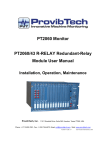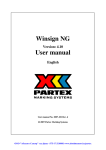Download PCL 735 12 channel Relay Actuator Card
Transcript
PCL-735 12-channel Relay Actuator Card Copyright This documentation is copyrighted 1996 by Advantech Co., Ltd. All rights are reserved. Advantech Co., Ltd. reserves the right to make improvements in the products described in this manual at any time without notice. No part of this manual may be reproduced, copied, translated or transmitted in any form or by any means without the prior written permission of Advantech Co., Ltd. Information provided in this manual is intended to be accurate and reliable. However, Advantech Co., Ltd. assumes no responsibility for its use, nor for any infringements of the rights of third parties which may result from its use. Acknowledgments PC-LabCard is a trademark of Advantech Co., Ltd. IBM and PC are trademarks of International Business Machines Corporation. MSDOS, Microsoft C and Quick BASIC are trademarks of Microsoft Corporation. BASIC is a trademark of Dartmouth College. Intel is a trademark of Intel Corporation. TURBO C is a trademark of Borland International. Part No. 2003735000 1st Edition Printed in Taiwan May 1996 Contents Chapter 1 General Information ......................................... 1 Introduction ....................................................................................2 Features ...........................................................................................2 Applications .....................................................................................2 Specifications ..................................................................................3 Relay Output ..................................................................................3 General ...........................................................................................3 Chapter 2 I n s t a l l a t i o n ........................................................... 5 Initial Inspection .............................................................................6 Switch and Jumper Settings ..........................................................7 Base address selection (SW1) ........................................................8 Hardware Installation ....................................................................9 Chapter 3 Signal Connections .......................................... 1 1 Connector Pin Assignments .........................................................12 Relay Output .................................................................................13 Appendix A Register Format ............................................... 1 5 Appendix B PC I/O Port Address Map ................................ 1 7 CHAPTER General 1 Information Chapter 1 General Information 1 Introduction Ideal for applications such as device On/Off control or signal switching, the PCL-735 12-channel relay actuator provides 12 electromechanical SPDT relays on a half-size card. To prevent relay fault, the On/Off status of each relay is easy to monitor. A red LED next to each relay shows its On/Off status, and the software can read each relay's status. Plus, an on-board DB-37 connector provides access to all output channels. Features • 12 relay outputs • LED relay status indicators • Male DB-37 matching connector included • Relay status readback function Applications • Industrial On/Off control • Signal switching • External relay driving 2 PCL-735 User's Manual Specifications Relay Output • Relay type: Single-pole double-throw (SPDT, Form C) • Output type: Ch0 to Ch11, normally open/normally closed • Contact rating: 2 A @ 30 VDC, 1 A @ 125 VAC • Breakdown voltage: 1000 V AC/DC min. • Relay on time: 5 msec. typical • Relay off time: 5 msec. typical • Total switching time: 10 msec. typical • Insulation resistance: 1000 MΩ @ 500 VDC min. • Life expectancy: > 5 x 105 operations @ 30 VDC and 2 A > 2 x 106 operations @ 30 VDC and 1 A General • Dimensions: 6.07" x 3.89" (155 mm x 99 mm) • I/O port address: Two consecutive bytes from hex 200 to 3F8 • Power consumption: +5 V @ 200 mA, +12 V @ 200 mA max. Chapter 1 General Information 3 4 PCL-735 User's Manual CHAPTER 2 Installation Chapter 2 Installation 5 Initial Inspection We carefully inspected the PCL-735 both mechanically and electrically before shipment. It should be free of marks and in perfect order on receipt. As you unpack the PCL-735, check it for signs of shipping damage (damaged box, scratches, dents, etc.). If it is damaged or fails to meet specifications, notify our service department or your local sales representative immediately. Also, call the carrier immediately and retain the shipping carton and packing material for inspection by the carrier. We will then make arrangements to repair or replace the unit. Discharge any static electricity on your body before you touch the board by touching the back of the system unit (grounded metal). Remove the PCL-735 card from its protective packaging by grasping the rear metal panel. Handle the card only by its edges to avoid static electric discharge which could damage its integrated circuits. Keep the antistatic package. Whenever you remove the card from the PC, please store the card in this package for protection. You should also avoid contact with materials that hold static electricity such as plastic, vinyl and styrofoam. 6 PCL-735 User's Manual Switch and Jumper Settings The PCL-735 card has one function switch (SW1). The following sections tell how to configure the card. Refer to the figure below for help identifying card components. CN1 SW1 Switch and Connector Locations Switches and Connectors Label CN1 SW1 Function Relay output Card base address Chapter 2 Installation 7 Base address selection (SW1) You control the PCL-735's operation by reading or writing data to the PC's I/O (input/output) port addresses. The PCL-735 requires two consecutive address locations. Switch SW1 sets the card's base (beginning) address. Valid base addresses range from Hex 200 to Hex 3F0. Other devices in your system may, however, be using some of these addresses. We set the PCL-735 for a base address of Hex 300 at the factory. If you need to adjust it to some other address range, set switch SW1 as shown in the following table: Card I/O addresses (SW1) Range (hex) Switch position 1 2 3 4 5 6 7 200 - 203 ¡ l l l l l l l 204 - 207 ⑨ * 300 - 303 ¡ l l l l l l ¡ ¡ ¡ l l l l l l ⑨ 3F0 - 3F3 ¡ ¡ ¡ ¡ ¡ ¡ l l ¡ = Off l = On 8 * = default Note: Switches 1-8 control the PC bus address lines as shown below: Switch 1 Line A9 2 A8 3 A7 4 A6 5 A5 6 A4 7 A3 8 A2 Appendix A provides a PC I/O port address map to help you avoid the I/O addresses for standard PC devices. 8 PCL-735 User's Manual Hardware Installation Warning! TURN OFF your PC power supply whenever you install or remove the PCL-735 or connect and disconnect cables. 1. Turn the computer off. Turn the power off to any peripheral devices such as printers and monitors. 2. Disconnect the power cord and any other cables from the back of the computer. 3. Remove the system unit cover (see the user's guide for your chassis if necessary). 4. Locate the expansion slots at the rear of the unit and choose any unused slot. 5. Remove the screw that secures the expansion slot cover to the system unit. Save the screw to secure the interface card retaining bracket. 6. Carefully grasp the upper edge of the PCL-735 card. Align the hole in the retaining bracket with the hole on top of the expansion slot and align the gold striped edge connector with the expansion slot socket. Press the board firmly into the socket. 7. Secure the PCL-735 using the screw you removed in step 5. 8. Attach any accessories (using 20 pin flat cables, a DB-37 cable, etc.) to the PCL-735. 9. Replace the system unit cover. Connect the cables you removed in step 2. Turn the computer power on. Chapter 2 Installation 9 10 PCL-735 User's Manual CHAPTER Signal 3 Connections Chapter 3 Signal Connections 11 Good signal connections can avoid a lot of unnecessary damage to your valuable PC and other hardware. This chapter gives pin assignments for each of the card's connectors and signal connections for different applications. Connector Pin Assignments The PCL-735 has a DB-37 connector accessible from the card bracket. Abbreviations NO NC Normally open Normally closed COM Common relay pin CN1 Pin Assignments NO0 COM0 NC0 NO1 COM1 NC1 NO2 COM2 NC2 NO3 COM3 NC3 NO4 COM4 NC4 NO5 COM5 NC5 N/A 12 PCL-735 User's Manual 1 2 3 4 5 6 7 8 9 10 11 12 13 14 15 16 17 18 19 20 21 22 23 24 25 26 27 28 29 30 31 32 33 34 35 36 37 NO6 COM6 NC6 NO7 COM7 NC7 NO8 COM8 NC8 NO9 COM9 NC9 NO10 COM10 NC10 NO11 COM11 NC11 Relay Output The PCL-735 has 12 channels of Single Pole Double Throw (SPDT) Form C relay output. Each relay has two Form C contacts, which are controlled by the same coil. One of the contacts is connected directly to CN1 for relay output, while the other contact controls the LED that displays the relay status, which can also be read back by a read command to the I/O port. KO VCC COM COM I/O port E VCC N.C. N.O. N.C. N.O. Load 1 E Load 2 A write operation to I/O address BASE+0 will change the output status of each relay. For example, if Bit 0 of BASE+0 is set to "1" (logic high), K0 (Relay 0) will switch from position NC0 (Normal Close) to position NO0 (Normal Open). This means that Load 2 is energized, while Load 1 is de-energized. In summary, when the bit has a value of "0" (power-on default), the corresponding COM line is in the "Normal Close" position. When the bit has a value of "1", the corresponding COM line is in the "Normal Open" position. Warning: External circuits connected to the PCL-735's relay ouput port must be fused at 1A or less and be rated at 120 VA or less. Voltage must not exceed the ±120V peak. Chapter 3 Signal Connections 13 14 PCL-735 User's Manual APPENDIX A Register Format Appendix A Register Format 15 Programming the PCL-735 is extremely simple. Each I/O channel corresponds to a bit in the card's registers. To turn on an output channel you write a ‘‘1” to the corresponding bit. The card requires four I/O register addresses. The address of each register is specified as an offset from the card's base address. For example, BASE+0 is the card's base address and BASE+2 is the base address + two bytes. If the card's base address is 300h, the register's address is 302h. See Chapter 2 for information on setting the card's base address. Register Assignments Address BASE+0 BASE+1 BASE+2 BASE+3 Write DO bits 0-7 DO bits 8-11 — — Register Read DI bits 0-7 status DI bits 8-11 status — — format BASE+0 D7 D6 D5 D4 D3 D2 D1 D0 N/A N/A N/A N/A D11 D10 D9 D8 BASE+1 Relay status for D n Setting Status 0 com N.C. N.O. 1 com N.C. N.O. Москва: 16 Телефон: (095) 234-0636 (4 линии) Факс: (095) 234-0640 BBS: (095) 336-2500 Web: http://www.prosoft.ru E-mail: [email protected] Для писем: 117313, Москва, а/я 81 PCL-735 User's Manual б





























